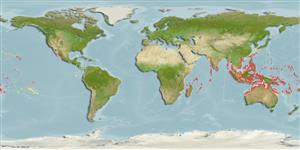Common names from other countries
Environment: milieu / climate zone / depth range / distribution range
Écologie
marin récifal; profondeur 8 - 30 m (Ref. 90102), usually 15 - 20 m (Ref. 48637). Tropical; 25°C - 28°C (Ref. 27115); 33°N - 25°S
Indo-Pacific: East Africa to the Marquesan and Society islands, north to the Ryukyu Islands, south to Vanuatu.
Taille / Poids / Âge
Maturity: Lm ? range ? - ? cm
Max length : 90.0 cm FL mâle / non sexé; (Ref. 1602)
Épines dorsales (Total) : 4 - 5; Rayons mous dorsaux (Total) : 28 - 30; Épines anales: 2; Rayons mous anaux: 27 - 28. Distinctive humped back; horn only in adult males. A few scattered small dark-edged pale spots on postorbital head and body above pectoral fins. No white margin posteriorly on caudal fin. Profile of snout from mouth to eye strongly sloping, forming an angle of about 40° to horizontal axis of body (Ref 9808).
Inhabits deep coastal, usually in small groups but occasionally in large schools (Ref. 48637). Sometimes solitary (Ref. 90102). An uncommon species found in seaward reef slopes (Ref. 9710, 48637), also along rocky shores (Ref. 30573). Feeds on benthic algae (Ref. 30573). Caught with nets (Ref. 30573).
Life cycle and mating behavior
Maturities | Reproduction | Spawnings | Egg(s) | Fecundities | Larves
Spawn in pairs (Ref. 240).
Myers, R.F., 1991. Micronesian reef fishes. Second Ed. Coral Graphics, Barrigada, Guam. 298 p. (Ref. 1602)
Statut dans la liste rouge de l'IUCN (Ref. 130435)
CITES (Ref. 128078)
Not Evaluated
Menace pour l'homme
Harmless
Utilisations par l'homme
Pêcheries: commercial; Aquarium: Commercial
Outils
Articles particuliers
Télécharger en XML
Sources Internet
Estimates based on models
Preferred temperature (Ref.
115969): 25.7 - 29, mean 28.1 (based on 218 cells).
Phylogenetic diversity index (Ref.
82804): PD
50 = 0.5000 [Uniqueness, from 0.5 = low to 2.0 = high].
Bayesian length-weight: a=0.01995 (0.00906 - 0.04395), b=3.00 (2.82 - 3.18), in cm Total Length, based on LWR estimates for this Genus-body shape (Ref.
93245).
Niveau trophique (Ref.
69278): 2.7 ±0.29 se; based on food items.
Résilience (Ref.
120179): Faible, temps minimum de doublement de population : 4,5 à 14 années (K=0.429; tmax=31).
Fishing Vulnerability (Ref.
59153): High vulnerability (60 of 100).
